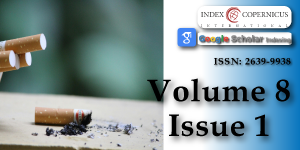Drug Abuse and Mental Illness in Erigavo Mental Hostiptal, Erigavo, Somalia
Main Article Content
Abstract
Mental illness is an international health crisis that puts the lives of over three hundred million people (Four percent of the world’s population) at risk. The study was conducted at the Erigavo Mental Hospital in Somaliland and its main focus was the bond between substance abuse and mental illness. The research was to check the influence of the different drugs, screen mental health problems, and draw a link between drugs and mental illness. The sources of the quantitative data were a total of 27 employees and managers. This study is cross-sectional. We employed the measure of the magnitude and direction of a linear relationship between two variables with the Pearson correlation coefficient. The outcomes that were acquired show that there was use and particularly abuse of khat, substance smoking, and alcohol consumption, the score means of which were quite high. The investigation results, however, imply that through drug use and other forms of alcohol drug abuse, one of them counter various mental health problems. Furthermore, the addicted people demonstrated the tendency to use force in their attempt to solve the conflicts and to experience the highest degree of tension, with the mean score of the former giving 4.11 while the standard deviation of the latter giving 1.086, thus this shows the mental impact of drug use on the inhabitants of Erigavo. The main result of the study was the strong, positive relationship between drug addiction and mental illness, which became evident through an r - value of 0.509 and a p - value of 0.559. It means that those people who are involved in drug misuse are the ones who are likely to have mental health disorders. Based on the findings of the study, we suggest a combination of measures to recover drug addiction and mental illness. This consists in strengthening prevention. The study that lays the groundwork for suggestions, involves an approach that is holistic in nature. The main ideas of preventing drug usage, psychological health care, enhancing mental health services, and working towards certified professionals are key integrated activities of the whole concept. The hospital, thus, will be in a better position to eliminate the two major disease components namely; drug abuse and mental ailment. Thus, in this way, with the help of the new treatment approaches, a hospital provides and their patients who are quite likely to recover and lead healthy.
Article Details
Copyright (c) 2024 Hassan MM, et al.

This work is licensed under a Creative Commons Attribution 4.0 International License.
Smith K. Mental health: a world of depression. Nature. 2014;515(7526):180-181. Available from: https://doi.org/10.1038/515180a
Librach SL, Emanuel LL. Palliative care: core skills and clinical competencies. Elsevier Health Sciences; 2011. Available from: Available from: https://www.sciencedirect.com/book/9781437716191/palliative-care.
Roberts S. Mental illness is a global problem: we need a global response. Available from: Available from: https://www.healthpovertyaction.org/news-events/mental-health-world-health-day-2017/#:~:text=Mental%20illness%20is%20a%20global%20problem.,mental%20ill%2Dhealth%20more%20generally.
World Health Organization. Comprehensive mental health action plan 2013–2030. 2021. Available from: https://www.who.int/publications/i/item/9789240031029.
World Health Organization. Mental health. 2022. Available from: https://www.who.int/news-room/fact-sheets/detail/mental-health-strengthening-our-response.
Regier DA, Kuhl EA, Kupfer DJ. The DSM‐5: Classification and criteria changes. World Psychiatry. 2013;12(2):92-98. Available from: https://doi.org/10.1002/wps.20050
Damena T, Mossie A, Tesfaye M. Khat chewing and mental distress: a community based study, in Jimma city, southwestern Ethiopia. Ethiop J Health Sci. 2011;21(1):37-46. Available from: https://doi.org/10.4314/ejhs.v21i1.69042
Mahamoud HD, Muse SM, Roberts LR, Fischer PR, Torbenson MS, Fader T. Khat chewing and cirrhosis in Somaliland: case series. Afr J Prim Health Care Fam Med. 2021;8(1). Available from: https://doi.org/10.4102/phcfm.v8i1.1124
Hansen P. The ambiguity of khat in Somaliland. J Ethnopharmacol. 2010;132(3):590-599. Available from: https://doi.org/10.1016/j.jep.2010.02.028
Hussein YZ, Wondimagegnhu BA, Misganaw GS. The effect of khat cultivation on rural households’ income in Bahir Dar Zuria District, Northwest Ethiopia. GeoJournal. 2023;88(2):1369-1388. Available from: https://doi.org/10.1007/s10708-022-10697-2
GAVO. Baseline survey report on mental health situation in Somaliland. Hayaat Women Trust Org. 2004. Available from: https://www.hayaatwomentrust.org/wp-content/uploads/2013/12/gavo_mental_health_somaliland.pdf
Schuckit MA. Comorbidity between substance use disorders and psychiatric conditions. Addiction. 2006;101:76-88. Available from: https://doi.org/10.1111/j.1360-0443.2006.01592.x
Morisano D, Babor TF, Robaina KA. Co-occurrence of substance use disorders with other psychiatric disorders: implications for treatment services. Nord Stud Alcohol Drugs. 2014;31(1):5-25. Available from: https://doi.org/10.2478/nsad-2014-0002
Tuchman E. Women and addiction: the importance of gender issues in substance abuse research. J Addict Dis. 2010;29(2):127-138. Available from: https://doi.org/10.1080/10550881003684582
Sogunro OA. Stress in school administration: coping tips for principals. J Sch Leadersh. 2012;22(3):664-700. Available from: https://doi.org/10.1177/105268461202200309
Edwards B, Atkins N. Exploring the association between khat use and psychiatric symptoms: a systematic review. BMJ Open. 2022;12(7):e061865. Available from: https://doi.org/10.1136/bmjopen-2022-061865

